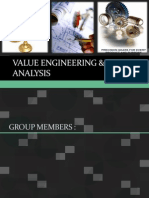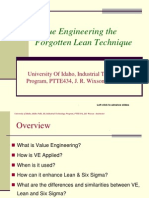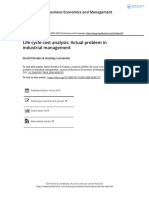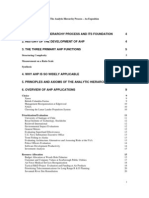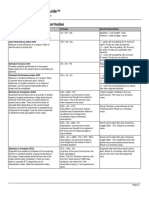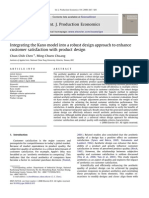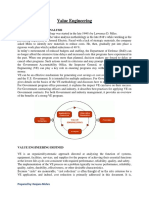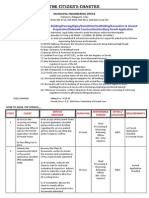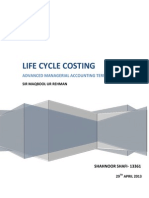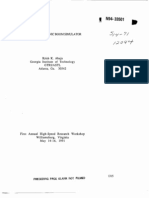0 ratings0% found this document useful (0 votes)
357 viewsValue Engineering Techniques & LCC Methods
Value Engineering Techniques & LCC Methods
Uploaded by
asdkjfThe document discusses value engineering techniques and life cycle costing (LCC). It provides definitions of key concepts in value engineering like functions, value, and worth. It explains the process of calculating LCC using the present worth and annualized methods. This involves determining costs at different stages of a project or product lifecycle, from acquisition to disposal. It also outlines two commonly used value engineering techniques - function-cost-worth analysis and function analysis system technique (FAST). The document limitations of LCC and discusses calculating the value gap and index.
Copyright:
© All Rights Reserved
Available Formats
Download as PPT, PDF, TXT or read online from Scribd
Value Engineering Techniques & LCC Methods
Value Engineering Techniques & LCC Methods
Uploaded by
asdkjf0 ratings0% found this document useful (0 votes)
357 views38 pagesThe document discusses value engineering techniques and life cycle costing (LCC). It provides definitions of key concepts in value engineering like functions, value, and worth. It explains the process of calculating LCC using the present worth and annualized methods. This involves determining costs at different stages of a project or product lifecycle, from acquisition to disposal. It also outlines two commonly used value engineering techniques - function-cost-worth analysis and function analysis system technique (FAST). The document limitations of LCC and discusses calculating the value gap and index.
Original Description:
Evaluation Phase -Making Informed Project Decisions
Copyright
© © All Rights Reserved
Available Formats
PPT, PDF, TXT or read online from Scribd
Share this document
Did you find this document useful?
Is this content inappropriate?
The document discusses value engineering techniques and life cycle costing (LCC). It provides definitions of key concepts in value engineering like functions, value, and worth. It explains the process of calculating LCC using the present worth and annualized methods. This involves determining costs at different stages of a project or product lifecycle, from acquisition to disposal. It also outlines two commonly used value engineering techniques - function-cost-worth analysis and function analysis system technique (FAST). The document limitations of LCC and discusses calculating the value gap and index.
Copyright:
© All Rights Reserved
Available Formats
Download as PPT, PDF, TXT or read online from Scribd
Download as ppt, pdf, or txt
0 ratings0% found this document useful (0 votes)
357 views38 pagesValue Engineering Techniques & LCC Methods
Value Engineering Techniques & LCC Methods
Uploaded by
asdkjfThe document discusses value engineering techniques and life cycle costing (LCC). It provides definitions of key concepts in value engineering like functions, value, and worth. It explains the process of calculating LCC using the present worth and annualized methods. This involves determining costs at different stages of a project or product lifecycle, from acquisition to disposal. It also outlines two commonly used value engineering techniques - function-cost-worth analysis and function analysis system technique (FAST). The document limitations of LCC and discusses calculating the value gap and index.
Copyright:
© All Rights Reserved
Available Formats
Download as PPT, PDF, TXT or read online from Scribd
Download as ppt, pdf, or txt
You are on page 1of 38
Management & Development of Complex Projects
Course Code - 706
MS Project Management
Value Engineering Techniques &
LCC
Lecture # 9
In previous Lecture, we have discussed about
Value engineering history & background
VA/VE Concept & definition
Value, value type, Mathematical expression of value
Reasons for poor value
Functions, levels of functions
Cost, direct material cost, direct labor cost, overhead cost
Life cycle cost
Summary of Previous Lecture
Life Cycle Cost
The Life cycle cost, which is also known as cradle to
grave cost, is the total cost from acquisition of an item
to the final disposal of the same after the life of the
item. The elements of Life cycle cost can be narrated
as:
1. Acquisition cost
2. Operational cost
3. Maintenance cost
4. Repair and replacement cost
5. Salvage cost
Project & Product Life-Cycle & LCC
Pre-Project Concept Design Imple-ment. Hand-over
M U D
Product Life-Cyle
Project Life-Cyle Operational Life-Cyle
Concept Design implem. Hand-over
M A I N T E N A N C E
Concept Design implem. Hand-over
U P G R A D E
Concept
Design
Imple-ment.
Hand-over
D
I
S
P
O
S
A
L
PROJECTS
- Fuel Consumption
- Oil Consumption
- Tyres Wear & Tear
- Parts Replacement
- Vehicle Depreciation
- Travel Time
- Accidents
15%
25%
10%
50%
Maintenance
Components of Total Road Transport Costs
Appreciation of Money Concept
If Rs 100 is invested in the bank at the interest rate of 10 per
cent on the first day of the year, then at the end of the year,
it will become Rs 110. In other words, the present value of
Rs 110, at the end of the year, is Rs 100
Year
Amount at Start
of Year
Interest Rate
Amount at End of
Year
1 100 10 % 110
2 110 10 % 121
3 121 10 % 133.1
4 133.1 10 % 146.31
Appreciation of Money Concept
The present value (beginning of the 1st year)
of Rs 146.31 (at the end of 4th year) is Rs
100.00. In a mathematical expression, the
factor which when multiplied by Rs 144.10 will
give Rs 100.00 is known as the Present Worth
Factor. In this case, it will be 0.6835
(100.00/146.31 = 0.6835).
Appreciation of Money Concept
Similarly, if one wants to distribute the present value
at the beginning of the year into all the four years (as
in this case), the present value has to be multiplied
with a factor which is known as the Capital Recovery
Factor. If one has to distribute the present worth of
Rs100.00 into four equal installments, the multiplying
Capital recovery factor will be 0.3165 for the interest
rate of 10 per cent.
Methods of Calculating Life Cycle Cost
There are two methods of calculating the Life cycle
cost. These are:
1. Present worth Method
2. Annualized Method
Procedure of Calculating LCC ; Present Worth Method
Acquisition cost: Since the acquisition cost is in the first day
of the calendar year, it is the present worth and its Present
worth factor is 1.
Operation and maintenance cost: These costs take place
every year. Using the discount rate and the year when
operation and maintenance cost recur, find out the Present
worth factor. Multiply the costs with those factors to achieve
the present worth of the individual item.
Repair and replacement cost: These are single payments
which may happen at any time of the life cycle. Using the
discount rate and the year when repair and replacement cost
recur, find out the Present worth factor. Multiply the costs with
those factors to achieve the present worth of the individual
item.
Procedure of Calculating LCC ; Present Worth Method
Salvage value: This will happen at the end of the life
cycle. This is the only item which is an income, when all
others are expenses. Using the discount rate and the
year when it is being salvaged, find out the Present
worth factor. Multiply the salvage value with that factor
to achieve the present worth of the item.
Life cycle cost: To arrive at the Life cycle cost, add
all the 3 items from last slide, then deduct item 4 from
(salvage value) that total.
Procedure of Calculating LCC ; Annualized Method
Acquisition cost: Since the acquisition cost is in the first day of
the calendar year, it is the present worth. To get the
annualized cost, it has to be multiplied by the Capital recovery
factor based on discount rate and the life of the items.
Operation and maintenance cost: These costs happen every
year. Hence, they do not require any further treatment.
Repair and replacement cost: These are single payments
which may happen at any time of the life cycle. Using the
discount rate and the year when repair and replacement cost
recur, fi nd out the Present worth factor. Multiply the costs with
those factors to achieve the present worth of the individual
item. To get the annualized cost, it has to be multiplied by the
Capital recovery factor based on discount rate and the life of
the items.
Procedure of Calculating LCC ; Annualized Method
Salvage value: This item will happen at the end of the
life cycle. This is the only item which is an income,
when all others are expenses. Using the discount rate
and the year when it is being salvaged, find out the
present worth factor. Multiply the salvage value with
that factor to achieve the Present worth of the item. To
get the annualized cost, it has to be multiplied by the
capital recovery factor based on discount rate and the
life of the items.
Life cycle cost: To arrive at the Life cycle cost, add
all the 3 items from last slide, then deduct item 4 from
(salvage value) that total.
Limitations of Life Cycle Costing
Life of the item: Determining the life of an item is difficult.
Interest rate: The interest rate may not be same every year.
Annual expenses: Annually operation and maintenance costs
are assumed as the expenses occurring at the end of the year
while calculating the LCC. Intermediate expenses are not
taken into consideration.
Quality/reliability: Not considering the quality and reliability of
the item, since the focus is only on costs. The lowest LCC item
may not be a good quality item.
Aesthetic: Not focusing on the esteem value of the item
Hence, the lowest LCC item may fail to add to the esteem of
the owner even though it provides the use value.
Comfort and safety: The comfort and safety of the customer
are not considered while determining the LCC. Hence, there is
a chance that the lowest LCC item may not provide sufficient
comfort/safety resulting in poor value to the customer.
Following are the two types of VE / VA techniques
which are most commonly used
FUNCTIONCOSTWORTH ANALYSIS
FUNCTION ANALYSIS SYSTEM TECHNIQUE (FAST)
Value Engineering Techniques
The Functioncostworth analysis is an excellent
tool to identify the value improvement potential in
any function.
This tool will not only help to identify the potential
but will also give some creative ideas as to how to
achieve that.
The ultimate aim of the Functioncostworth
analysis is to find out the value improvement in
various functions. Based on these findings, the team
will approach the problem.
FUNCTIONCOSTWORTH ANALYSIS
Worth is the minimum cost of achieving a function.
Worth is an indispensable element of VE.
Worth varies with time.
Worth depends upon information.
Worth is usually determined by developing or thinking
of other methods of performing functions.
Worth is just a technique, not an absolute value.
Where an item has several functions, determine
worth of each function separately and add them to
get overall worth.
Concept of Worth
Split the product into components and service/system into activities.
Define functions of components/activities.
Divide the total cost of product/service/system into components/
activities cost.
Processes performed to achieve particular function; cost allocated to
that function.
Component provided to achieve particular function; cost allocated to
that function.
Component accomplishes more than one function; allocation should
be based on weight, volume, surface area and length.
Hold each function in isolation of the others to do this.
Procedure for Cost Allocation
The difference between cost and worth is known as
value gap. It indicates the scope of possible value
improvement.
The value index is the ratio of cost by worth. In
other words, it is the cost per unit of worth. When
the index is more than one, it means there is
potential for value improvement.
Value Gap and Value Index
Write down all functions for the project as a whole.
Divide the project into parts.
Function(s) of each part to be defined in two words.
An active verb and a measurable noun.
Apply three tests to identify the basic and secondary functions.
Is this function what users are looking for?
Yes: Basic No: Secondary
If this function is eliminated, will the item continue to do the job?
No: Basic Yes: Secondary
Will the function disappear, if the design approach is changed?
No: Basic Yes: Secondary
Steps for functioncostworth analysis
Cost of each part to be ascertained.
Cost of the part to be transformed into function.
Check whether the cost of the functions are equal to the sum
of the costs of the parts.
Assess the worth (least cost of achieving) functions.
First list all functions and costs in descending order.
Then ask the following questions:
Will you pay if it is your money?
If not, what do you consider reasonable?
By whom or where a similar function is available at lower cost?
What should you do to obtain the function within that cost?
Steps for functioncostworth analysis
Example for functioncostworth analysis
The FAST is a Systematic Diagramming
Technique that logically identifies and visually
displays the necessary function to accommodate
a design purpose
Definition of FAST
Classic FAST
Technically Oriented FAST
Customer Oriented FAST
Different Types of FAST
Prepare a list of all functions.
Use verb and noun to define a function.
Write each function in a small card.
Involve the whole team in the diagramming exercise.
Select the card which appears to be basic function.
Apply logical question how and why on selected
function to determine functions to right and left on this
selected function.
Functions satisfy howwhy logic are required
secondary functions to be put in line.
Steps for The FAST diagram (Technically Oriented)
Draw scope line (dotted line) on left side of basic function.
Higher order function on the left side of scope line.
All time function to be placed in right hand top corner above
critical path.
Design objectives is placed above the basic function.
Functions that happen at the same time placed below that
function.
Right scope line (dotted) to be drawn left of function that is
suitable input to the system.
Function right to the right side of right scope line is lower
order/causative function
Steps for The FAST diagram (Technically Oriented)
FAST diagram (Technically Oriented)
A key point of the organized VE effort is the use of
the Job Plan. The Job Plan is the organized
problem-solving approach that separates VE from
other cost-cutting exercises. The simplest Job Plan
follows a five-step approach that is integral to VE
methodology. Key questions are answered at each
stage.
VE Job Plan
1. Information Gathering Step
What functions are being provided?
What do the functions cost?
What are the functions worth?
What functions must be accomplished?
2. Creativity & Idea Generation
What else will perform the function?
How else may the function be performed?
3. Analyze Ideas/Evaluation & Selection
Will each idea perform the required functions?
How might each idea be made to work?
VE Job Plan Steps
4. Development of Proposal
How will the new idea work?
Will it meet all the requirements?
How much will it cost?
What is the LCC impact?
5. Presentation/ implementation & Follow-up
Why is the new idea better?
Who must be sold on the idea?
What are the advantages/disadvantages and specific
benefits!
What is needed to implement the proposal?
VE Job Plan Steps
VE Job Plan Steps
Creativity is the art of imagination which brings
something new to existence.
Discovery of something that is novel, useful,
relevant, economical, significant and different from
the beaten track.
CREATIVITY
Creativity is the preserve of geniuses
Certain people are born creative
Creativity must result in a great discovery.
This always persists in their mind.
Misconceptions about Creativity
Habitual block
Perceptual block
Cultural block
Emotional block
Blocks to Creativity
Brainstorming
The pareto principle ABC analysis
Gordon technique
Attribute listing
Morphological analysis
Laddering
Creativity Techniques
In this Lecture, we have discussed about
Life cycle cost
Appreciation of money concept
Methods of life cycle costing, Annualized Method & present
worth method
Limitation of LCC
VE Techniques; function, cost worth analysis & function
analysis system technique
Concept of worth
VE Job plan
Creativity
Summary of This Lecture
End Note
One machine can do the work of fifty ordinary
men. No machine can do the work of one
Project Manager
THANK YOU!
You might also like
- PreviewpdfDocument66 pagesPreviewpdfmdiez775No ratings yet
- The End of SilosDocument15 pagesThe End of SilosN. AndradeNo ratings yet
- CVS Certification ManualDocument32 pagesCVS Certification Manual황상훈No ratings yet
- Eow l2 Scope and SequenceDocument2 pagesEow l2 Scope and SequenceOanh Nguyen KieuNo ratings yet
- Value Analysis & Flexible Project Appraisal: Presented by M H Nadeem (F-10) Sandeep Jadhav (F-)Document30 pagesValue Analysis & Flexible Project Appraisal: Presented by M H Nadeem (F-10) Sandeep Jadhav (F-)mhnadeemNo ratings yet
- Report FAST-Sling BagDocument13 pagesReport FAST-Sling BagSmith Surya PermanaNo ratings yet
- Value MethodologyDocument21 pagesValue Methodology1SABNo ratings yet
- Value Methodology Standard: DRAFT Consultation Document July 2005Document24 pagesValue Methodology Standard: DRAFT Consultation Document July 2005José Alberto Gonzales OchoaNo ratings yet
- Production Management: Lecture No 5 Resource Person: Engr Muhammad Raheel ButtDocument40 pagesProduction Management: Lecture No 5 Resource Person: Engr Muhammad Raheel ButtZeeshan QaraNo ratings yet
- Value Engineering & Value AnalysisDocument49 pagesValue Engineering & Value AnalysisFaran ShaikhNo ratings yet
- How To Read A FAST DiagramDocument2 pagesHow To Read A FAST DiagramNur AfiqahNo ratings yet
- Value AnalysisDocument6 pagesValue AnalysisLln PsgnNo ratings yet
- 4183-2007 Australian Standard Value ManagementDocument10 pages4183-2007 Australian Standard Value Managementsenzo scholarNo ratings yet
- Comparison of Designer ObjectivesDocument4 pagesComparison of Designer ObjectivesViraj RaneNo ratings yet
- Value Methodology StandardDocument19 pagesValue Methodology StandardAmany TantawyNo ratings yet
- VE2Document90 pagesVE2Avinash M. KatkarNo ratings yet
- Life Cycle CostingDocument12 pagesLife Cycle CostingTasha Derahman0% (1)
- Life Cycle Cost Analysis Actual Problem in Industrial ManagementDocument5 pagesLife Cycle Cost Analysis Actual Problem in Industrial ManagementMohammad QureshiNo ratings yet
- Value Management PDFDocument3 pagesValue Management PDFManVasNo ratings yet
- Analytic Hierarchy ProcessDocument86 pagesAnalytic Hierarchy Processstu_aroNo ratings yet
- Value Methodology Glossary PDFDocument4 pagesValue Methodology Glossary PDFCalNo ratings yet
- Value EngineeringDocument24 pagesValue EngineeringRisira Erantha KannangaraNo ratings yet
- Value Analysis: Presented By: Radhika Swarup Jeevitha Reddy Mba Ii SemDocument28 pagesValue Analysis: Presented By: Radhika Swarup Jeevitha Reddy Mba Ii Semjasmine2589No ratings yet
- PMP FormulaDocument7 pagesPMP FormulakhotrucNo ratings yet
- Value Engineering: Ahmed ElyamanyDocument52 pagesValue Engineering: Ahmed Elyamanysharfutaj100% (1)
- SE - Requirement EngineeringDocument53 pagesSE - Requirement EngineeringAdarsh PatilNo ratings yet
- Fast Diagram PDFDocument16 pagesFast Diagram PDFROHIT SINGHNo ratings yet
- FAST (Functional Analysis System Technique)Document11 pagesFAST (Functional Analysis System Technique)abilash_nivas100% (1)
- Pointer and Array Review & Introduction To Data StructureDocument39 pagesPointer and Array Review & Introduction To Data Structurebryan chandraNo ratings yet
- Monograph Function: Definition and AnalysisDocument13 pagesMonograph Function: Definition and AnalysisdesignbaseNo ratings yet
- Value Methodology - A Pocket Guide to Reduce Cost and Improve Value Through Function Analysis-مفتوحDocument85 pagesValue Methodology - A Pocket Guide to Reduce Cost and Improve Value Through Function Analysis-مفتوحAlaa MohamedNo ratings yet
- Lecture Notes - Value ManagementDocument9 pagesLecture Notes - Value Managementsympathhia100% (1)
- Kano Model For Mobile Phone DesigningDocument15 pagesKano Model For Mobile Phone Designingguru9anandNo ratings yet
- Value Engineering NotesDocument39 pagesValue Engineering Notesashish kumarNo ratings yet
- Value ManagementDocument3 pagesValue Managementistanbul1453No ratings yet
- Building PermitDocument2 pagesBuilding PermitLilian Laurel CariquitanNo ratings yet
- From Pmbok (Project Management Body of Knowledge) Guide: What Is Value Engineering?Document7 pagesFrom Pmbok (Project Management Body of Knowledge) Guide: What Is Value Engineering?marisevenNo ratings yet
- Advanced Construction Project Management The Complexity of MegaprojectsDocument290 pagesAdvanced Construction Project Management The Complexity of MegaprojectsGeorge MachaNo ratings yet
- Value AnalysisDocument21 pagesValue AnalysisVELMURUGAN MNo ratings yet
- VMSTDDocument5 pagesVMSTDragavendarraja50% (2)
- Project Management: Group V Bsa-1ADocument38 pagesProject Management: Group V Bsa-1AAngela Lei SanJuan BucadNo ratings yet
- Outline: Software Engineering For Software-Intensive Systems: IV RequirementsDocument11 pagesOutline: Software Engineering For Software-Intensive Systems: IV Requirementsvar6212No ratings yet
- IQN CPMA Body of Knowledge 2023Document167 pagesIQN CPMA Body of Knowledge 2023shatilNo ratings yet
- BS ISO 1568 UK in CONSTRUCTIONDocument31 pagesBS ISO 1568 UK in CONSTRUCTIONṀ२ि٠ƁⱢʘƝƬȞ͜͡六ƝƘ ❽ƁƤ FNo ratings yet
- Ahmed El Antary - PMP Part 1 - 5th Ed - GeneralDocument23 pagesAhmed El Antary - PMP Part 1 - 5th Ed - GeneralAhmed El AntaryNo ratings yet
- Life Cycle Cost AnalysisDocument7 pagesLife Cycle Cost AnalysisDenilson MarinhoNo ratings yet
- Life Cycle Costing Product Life Cycle Project Life CycleDocument7 pagesLife Cycle Costing Product Life Cycle Project Life CycleShubham KesarkarNo ratings yet
- 06 Value EngineeringDocument3 pages06 Value EngineeringMahesh JayawardanaNo ratings yet
- Life Cycle Cost Analysis (LCCA)Document14 pagesLife Cycle Cost Analysis (LCCA)Akshay WaimNo ratings yet
- The Systems Thinking Tool Box: DR Stuart BurgeDocument11 pagesThe Systems Thinking Tool Box: DR Stuart BurgeSamuel ZvimbaNo ratings yet
- Chapter 23 - Project Planning: Introduction and ProcessDocument70 pagesChapter 23 - Project Planning: Introduction and Processlethall1ma0% (1)
- Chapter4 SPM Project Integration ManagementDocument52 pagesChapter4 SPM Project Integration Managementirapurple03No ratings yet
- Use For BODDocument12 pagesUse For BODmkmusaNo ratings yet
- M5 - Facility Management PhilosophiesDocument7 pagesM5 - Facility Management PhilosophiesOreo De VeraNo ratings yet
- Describing Function AnalysisDocument84 pagesDescribing Function AnalysisAnirban GhoseNo ratings yet
- Life Cycle CostingDocument23 pagesLife Cycle CostingPriyanka RaiNo ratings yet
- Depreciation Provisions and Reserves Class 11 NotesDocument48 pagesDepreciation Provisions and Reserves Class 11 Notesjainayan8190No ratings yet
- Product Life Cycle Cost Management (Final)Document14 pagesProduct Life Cycle Cost Management (Final)Abhirup UbaleNo ratings yet
- Life Cycle Cost AnalysisDocument32 pagesLife Cycle Cost Analysisaamritaa100% (1)
- Life Cycle Costing ReportDocument18 pagesLife Cycle Costing ReportShahnoor ShafiNo ratings yet
- Life Cycle Cost AnalysisDocument39 pagesLife Cycle Cost AnalysisRohit Rupani100% (1)
- Life Cycle Costing: Advanced Managerial Accounting Term ReportDocument18 pagesLife Cycle Costing: Advanced Managerial Accounting Term ReportNova Blue ComputingNo ratings yet
- Connections Remembered, Forgotten and NeglectedDocument4 pagesConnections Remembered, Forgotten and NeglectedNorm FriesenNo ratings yet
- Writing Tests 1-30 (B1B2C1 - ÉHTN)Document34 pagesWriting Tests 1-30 (B1B2C1 - ÉHTN)Vũ Minh HiếuNo ratings yet
- Sonic Boom GeneratorDocument28 pagesSonic Boom Generatorsoho54No ratings yet
- Grand Final THESISDocument67 pagesGrand Final THESISMaravillas JenNo ratings yet
- 101 Review QuestionsDocument6 pages101 Review QuestionsLại Lê Gia HânNo ratings yet
- Welcome Letter For HCL Technologies Recruitment Drive & Online Internship Joining ProgramDocument1 pageWelcome Letter For HCL Technologies Recruitment Drive & Online Internship Joining Programsudharsanv7303No ratings yet
- PVGTR 2004 18eDocument24 pagesPVGTR 2004 18esmackdooriNo ratings yet
- LP Unit 14 Y5Document7 pagesLP Unit 14 Y5Shaliza Abdul Said100% (1)
- Chap 10 AnswerDocument4 pagesChap 10 AnswerNancy VõNo ratings yet
- Upcat 2024 Form1 1245385957Document2 pagesUpcat 2024 Form1 1245385957San Pedro MandanoNo ratings yet
- Action Research Arm TestDocument3 pagesAction Research Arm TestDiedeeNo ratings yet
- Dmgt517 Performance Management SystemDocument175 pagesDmgt517 Performance Management Systemneha100% (1)
- IndianJAnaesth63136-5446753 150747Document6 pagesIndianJAnaesth63136-5446753 150747deepikaNo ratings yet
- WP Spi 2015 Professional Services Maturity BenchmarkDocument202 pagesWP Spi 2015 Professional Services Maturity BenchmarkInvestigaciones EconómicasNo ratings yet
- What Is The Difference Between MCB, MCCB, ELCB, and RCCBDocument7 pagesWhat Is The Difference Between MCB, MCCB, ELCB, and RCCBYousif_AbdalhalimNo ratings yet
- Modbus Implementation in APC Smart-UPS v12Document30 pagesModbus Implementation in APC Smart-UPS v12bahramNo ratings yet
- Prices Effective Dated December 01 2017Document10 pagesPrices Effective Dated December 01 2017Muhammad KashifNo ratings yet
- Reading 42.6 Standards of Professional Conduct Guidance For Standards VIDocument20 pagesReading 42.6 Standards of Professional Conduct Guidance For Standards VItristan.riolsNo ratings yet
- Material Science and Engineering: "Metals"Document31 pagesMaterial Science and Engineering: "Metals"Baltazar MharkNo ratings yet
- Brain-Based Computer Interfaces in Virtual RealityDocument6 pagesBrain-Based Computer Interfaces in Virtual RealityJorge HernándezNo ratings yet
- Quick Progrommet Installation: 225Mm 300Mm 375Mm 450Mm 525Mm 600Mm 750Mm 900Mm 100Mm 150Mm 30185 30186 30188 30177 30178Document2 pagesQuick Progrommet Installation: 225Mm 300Mm 375Mm 450Mm 525Mm 600Mm 750Mm 900Mm 100Mm 150Mm 30185 30186 30188 30177 30178Barrasons Engineers TeamNo ratings yet
- Effect of Salinity On Germination and Seed PhysiologyDocument4 pagesEffect of Salinity On Germination and Seed PhysiologyhunarsandhuNo ratings yet
- Class IX - Physics Practical - Part 2Document10 pagesClass IX - Physics Practical - Part 2Hinndol GamingNo ratings yet
- Digital Smile DesigningDocument7 pagesDigital Smile Designingashikiqbal841No ratings yet
- Transtec 5 85W-140 MSDSDocument5 pagesTranstec 5 85W-140 MSDSstevanykurnia100% (1)
- HS Unit 1. Life Stories We Admire. - Global Success 12Document11 pagesHS Unit 1. Life Stories We Admire. - Global Success 12Suga MinNo ratings yet
- Mutu Beton Standar EropaDocument1 pageMutu Beton Standar EropaDedy RachayuNo ratings yet
- Kinematics of Linear Motion - NotesDocument2 pagesKinematics of Linear Motion - Notes莫真露No ratings yet









